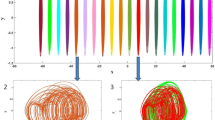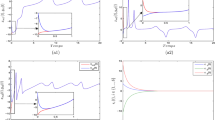Abstract
The purpose of this research is to address the problem of synchronization between two identical biological hyperchaotic snap oscillator systems with unknown parameters at a fixed time, as well as to design a new theory for synchronizing two different chaotic systems. Firstly, we designed an adaptive controller using Lyapunov stability and fixed-time stability theory to achieve synchronization between two identical biological hyperchaotic snap oscillator in fixed time under unknown parameters. Among the results obtained, we found that the synchronization time for system states occurred in a very short time compared to results in previous research. Secondly, we extended and generalized synchronization between non-identical chaotic systems by creating a theory for achieving synchronization in which adaptive control and fixed-time stability are combined. Through the new theory, the unknown parameters in chaotic systems were estimated, and the settling time was determined, which turned out to be very short and independent of the initial conditions of the system states. One of what makes the scheme important is that it can be easily applied to most chaotic and even hyperchaotic systems in the shortest possible time. Finally, we gave examples of different systems to test the feasibility and effectiveness of the scheme that was designed.









Similar content being viewed by others
Data availability
Data sharing not applicable to this article as no datasets were generated or analyzed during the current study.
References
Yang HM (2023) Thresholds, bifurcation and chaos in biological phenomena: Comment on “mathematical models for dengue fever epidemiology: A 10-year systematic review’’ by m. aguiar et al. Phys Life Rev 44:6–8. https://doi.org/10.1016/j.plrev.2022.11.005
Rather SA, Bala PS (2020) Swarm-based chaotic gravitational search algorithm for solving mechanical engineering design problems. World J Eng 17(1):97–114. https://doi.org/10.1108/WJE-09-2019-0254
Yousefpour A, Jahanshahi H, Munoz-Pacheco JM, Bekiros S, Wei Z (2020) A fractional-order hyper-chaotic economic system with transient chaos. Chaos, Solitons & Fractals 130:109400. https://doi.org/10.1016/j.chaos.2019.109400
Torkura KA, Sukmana MI, Cheng F, Meinel C (2020) Cloudstrike: Chaos engineering for security and resiliency in cloud infrastructure. IEEE Access 8:123044–123060. https://doi.org/10.1109/ACCESS.2020.3007338
Minati L, Gambuzza L, Thio W, Sprott J, Frasca M (2020) A chaotic circuit based on a physical memristor. Chaos, Solitons & Fractals 138:109990. https://doi.org/10.1016/j.chaos.2020.109990
Blasius B, Stone L (2000) Chaos and phase synchronization in ecological systems. Int J Bifurc Chaos 10(10):2361–2380. https://doi.org/10.1142/S0218127400001511
Roohi M, Zhang C, Chen Y (2020) Adaptive model-free synchronization of different fractional-order neural networks with an application in cryptography. Nonlinear Dyn 100(2):3979–4001. https://doi.org/10.1007/s11071-020-05719-y
Sifeu T K, Cyrille A, Victor K, Jean Chabi O (2020) Directly modulated semiconductor ring lasers: Chaos synchronization and applications to cryptography communications. Chaos Theory Appl 2(1):31–39
Samimi M, Majidi MH, Khorashadizadeh S (2020) Secure communication based on chaos synchronization using brain emotional learning. AEU-Int J Electron Commun 127:153424. https://doi.org/10.1016/j.aeue.2020.153424
Gokyildirim A, Kocamaz UE, Uyaroglu Y, Calgan H (2013) A novel five-term 3d chaotic system with cubic nonlinearity and its microcontroller-based secure communication implementation. AEU-Int J Electron Commun 160:154497. https://doi.org/10.1016/j.aeue.2022.154497
Wang L, Wang J, Wu Y, Sun Y, Li S, Yan L, Wang Y, Wang A (2023) Chaos synchronization of semiconductor lasers over 1040-km fiber relay transmission with hybrid amplification. Photonics Res 11(6):953–960. https://doi.org/10.1364/PRJ.478487
Manhil MM, Jamal RK (2023) Effect of nonlinear properties of chaotic systems on the behavior of semiconductor lasers. J Opt, 1–6. https://doi.org/10.1007/s12596-023-01409-1
Marghoti G, Ferrari F.A.S, Viana R.L, Lopes S.R, Prado T.d.L (2023) Coupling dependence on chaos synchronization process in a network of rulkov neurons. Int J Bifurc Chaos 33(11):2350132. https://doi.org/10.1142/S0218127423501328
Heilat AS, Karoun RC, Al-Husban A, Abbes A, Al Horani M, Grassi G, Ouannas A (2023) The new fractional discrete neural network model under electromagnetic radiation: Chaos, control and synchronization. Alex Eng J 76:391–409. https://doi.org/10.1016/j.aej.2023.06.017
Ma R-R, Wu J, Wu K, Pan X (2020) Adaptive fixed-time synchronization of lorenz systems with application in chaotic finance systems. Nonlinear Dyn 109(4):3145–3156. https://doi.org/10.1007/s11071-022-07598-x
Wang S, He S, Yousefpour A, Jahanshahi H, Repnik R, Perc M (2020) Chaos and complexity in a fractional-order financial system with time delays. Chaos, Solitons & Fractals 131:109521. https://doi.org/10.1016/j.chaos.2019.109521
Takhi H, Kemih K, Moysis L, Volos C (2020) Passivity based control and synchronization of perturbed uncertain chaotic systems and their microcontroller implementation. Int J Dyn Control 8:973–990. https://doi.org/10.1007/s40435-020-00618-x
Munoz-Pacheco JM, Volos C, Serrano FE, Jafari S, Kengne J, Rajagopal K (2021) Stabilization and synchronization of a complex hidden attractor chaotic system by backstepping technique. Entropy 23(7):921. https://doi.org/10.3390/e23070921
Zambrano-Serrano E, Bekiros S, Platas-Garza MA, Posadas-Castillo C, Agarwal P, Jahanshahi H, Aly AA (2021) On chaos and projective synchronization of a fractional difference map with no equilibria using a fuzzy-based state feedback control. Phys A: Stat Mech Appl 578:126100. https://doi.org/10.1016/j.physa.2021.126100
Kumar A, Singh PP (2023) Synchronisation of unified chaotic systems using modified nonlinear active control: Circuit design, implementation, and secure communication. IETE J Res 69(10):7141–7157. https://doi.org/10.1080/03772063.2022.2060873
Kuz’menko A.A (2022) Forced sliding mode control for chaotic systems synchronization. Nonlinear Dyn 109(3):1763–1775. https://doi.org/10.1007/s11071-022-07552-x
Ouahabi R, Hamri N-E (2021) Design of new scheme adaptive generalized hybrid projective synchronization for two different chaotic systems with uncertain parameters. Discret & Contin Dyn Syst-Ser B, 26(5). https://doi.org/10.3934/dcdsb.2020182
Hamri N-E, Ouahabi R (2015) Modified projective synchronization of different chaotic systems using adaptive control. Comput Appl Math 36:1315–1332. https://doi.org/10.1007/s40314-015-0294-4
Khattar D, Agrawal N, Singh G (2023) Anti-difference quadratic compound synchronization of lorenz, rössler, modified finance, and shimizu-morioka chaotic systems. Indian J Phys 98(4):415–1423. https://doi.org/10.1007/s12648-023-02893-8
Khattar D, Agrawal N, Singh G (2023) Triple compound combination synchronization of eleven n-dimensional chaotic systems. Int J Dyn Control 11(5):2499–2513. https://doi.org/10.1007/s40435-023-01140-6
Bhat SP, Bernstein DS (2000) Finite-time stability of continuous autonomous systems. SIAM J Control Optim 38(3):751–766. https://doi.org/10.1137/S0363012997321358
Pang H, Liu S (2021) Robust finite time passivity and stabilization of uncertain switched nonlinear system. IEEE Access 9:36173–36180. https://doi.org/10.1109/ACCESS.2021.3062661
Du H, Li S, Qian C (2011) Finite-time attitude tracking control of spacecraft with application to attitude synchronization. IEEE Trans Autom Control 56(11):2711–2717. https://doi.org/10.1109/TAC.2011.2159419
Wang L, Dong T, Ge M-F (2019) Finite-time synchronization of memristor chaotic systems and its application in image encryption. Appl Math Comput 347:293–305. https://doi.org/10.1016/j.amc.2018.11.017
Polyakov A (2011) Nonlinear feedback design for fixed-time stabilization of linear control systems. IEEE Trans Autom Control 57(8):2106–2110. https://doi.org/10.1109/TAC.2011.2179869
Ni J, Liu L, Liu C, Hu X, Li S (2016) Fast fixed-time nonsingular terminal sliding mode control and its application to chaos suppression in power system. IEEE Trans Circuits Syst II: Express Br 64(2):151–155. https://doi.org/10.1109/TCSII.2016.2551539
Yang W, Xiao L, Huang J, Yang J (2021) Fixed-time synchronization of neural networks based on quantized intermittent control for image protection. Mathematics 9(23):3086. https://doi.org/10.3390/math9233086
Degn H, Holden AV, Olsen LF (1987) Chaos in Biological Systems. Springer, New York. https://doi.org/10.1007/978-1-4757-9631-5
Olusola OI, Vincent E, Njah AN, Ali E (2011) Control and synchronization of chaos in biological systems via backsteping design. Int J Nonlinear Sci 11(1):121–128. https://doi.org/10.1186/s13662-021-03224-z
Iqbal J, Ahmad S, Marwan M, Shaukat M (2020) Control and numerical analysis for cancer chaotic system. Arch Appl Mech 90:2597–2608. https://doi.org/10.1007/s00419-020-01748-6
Alshomrani AS, Ullah MZ, Baleanu D (2021) A new approach on the modelling, chaos control and synchronization of a fractional biological oscillator. Adv Differ Equ 2021:1–20. https://doi.org/10.1186/s13662-021-03224-z
Vaidyanathan S (2015) Global chaos synchronization of the lotka-volterra biological systems with four competitive species via active control. Int J PharmTech Res 8(6):206–217
Sajjadi S.S, Baleanu D, Jajarmi A, Pirouz H.M (2020) A new adaptive synchronization and hyperchaos control of a biological snap oscillator. Chaos, Solitons & Fractals 138:109919. https://doi.org/10.1016/j.chaos.2020.109919
Vaidyanathan S, Feki M, Sambas A, Lien C-H (2018) A new biological snap oscillator: its modelling, analysis, simulations and circuit design. Int J Simul Process Modelling 13(5):419–432. https://doi.org/10.1504/IJSPM.2018.094734
Liu S, Chen C, Peng H, others (2020) Fixed-time synchronization of neural networks with discrete delay. Math Probl Eng, 2020 . https://doi.org/10.1155/2020/7830547
Polyakov A (2011) Nonlinear feedback design for fixed-time stabilization of linear control systems. IEEE Trans Autom Control 57(8):2106–2110. https://doi.org/10.1109/TAC.2011.2179869
Khalil HK (2002) Nonlinear systems. Prentice Hall, Hoboken
Liu C, Liu T, Liu L, Liu K (2004) A new chaotic attractor. Chaos, Solitons & Fractals 22(5):1031–1038. https://doi.org/10.1016/j.chaos.2004.02.060
Author information
Ethics declarations
Conflict of interest
The author declares that they have no conflict of interest.
Additional information
Publisher's Note
Springer Nature remains neutral with regard to jurisdictional claims in published maps and institutional affiliations.
Rights and permissions
Springer Nature or its licensor (e.g. a society or other partner) holds exclusive rights to this article under a publishing agreement with the author(s) or other rightsholder(s); author self-archiving of the accepted manuscript version of this article is solely governed by the terms of such publishing agreement and applicable law.
About this article
Cite this article
Ouahabi, R., Boulezaz, C. A novel approach to synchronizing a biological snap oscillator within a fixed time and expanding the method to various chaotic systems. J Supercomput (2024). https://doi.org/10.1007/s11227-024-06161-2
Accepted:
Published:
DOI: https://doi.org/10.1007/s11227-024-06161-2




